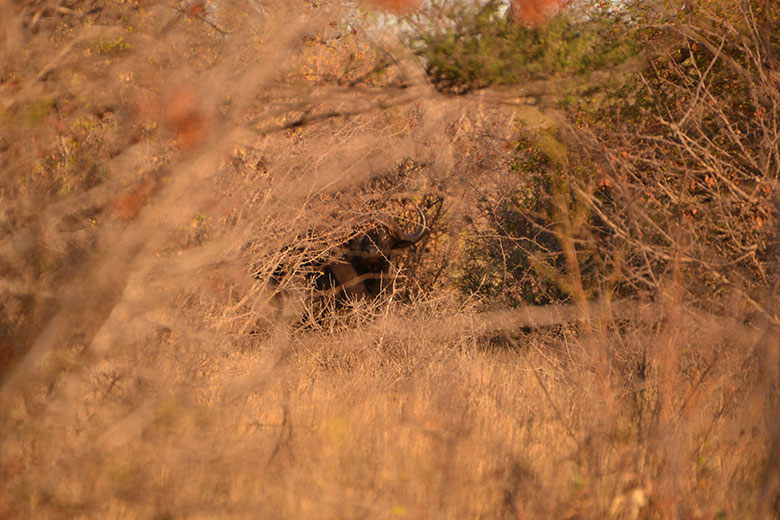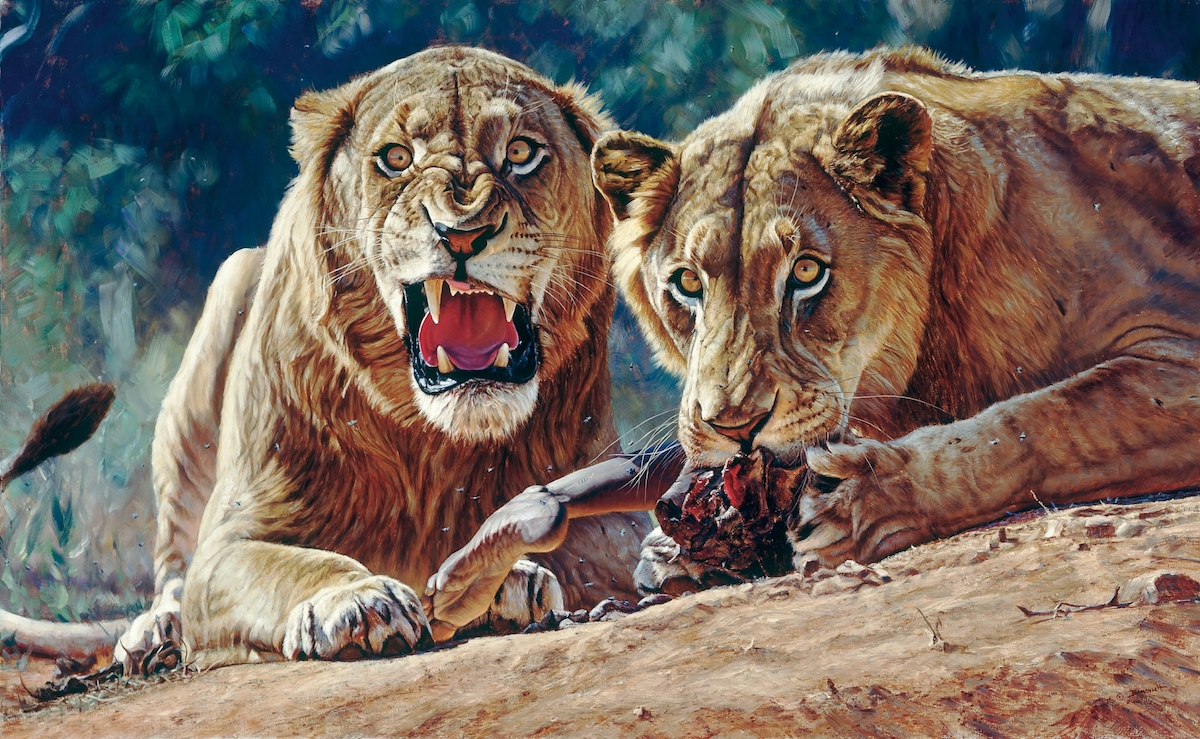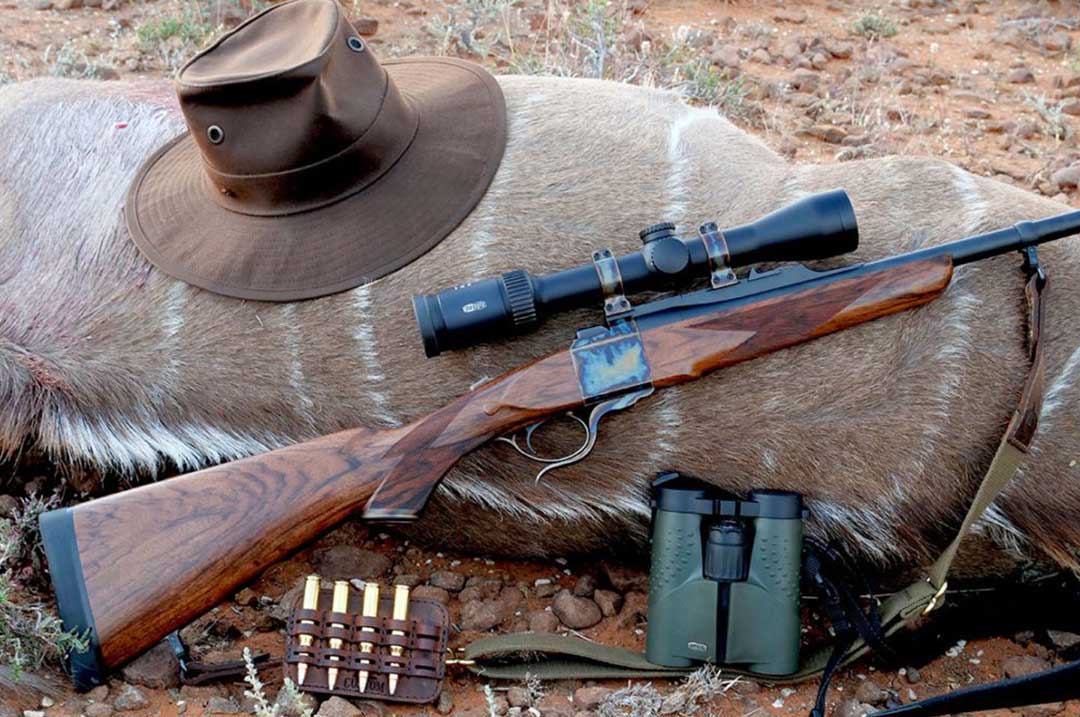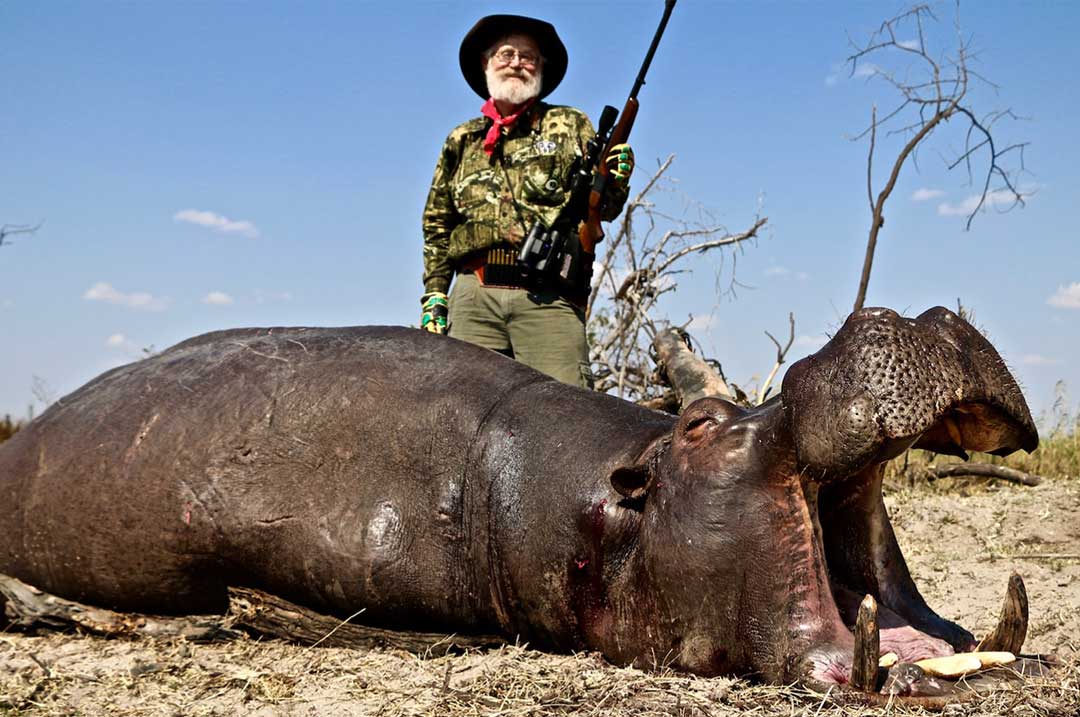This was not our first safari, but this one was far more complex. We would hunt Cape buffalo, our first endeavor of such magnitude.
Situations can quickly get out of hand when hunting Cape buffalo. This possibility is particularly enhanced when the pursuit is conducted in bushveld, a landscape defined by near impenetrable vegetation festooned with thorns and occupied by tangles that can render the visitor facedown and immobile rather than upright and in judicious retreat. But that is exactly where we were – in the thick stuff and looking for buffalo.
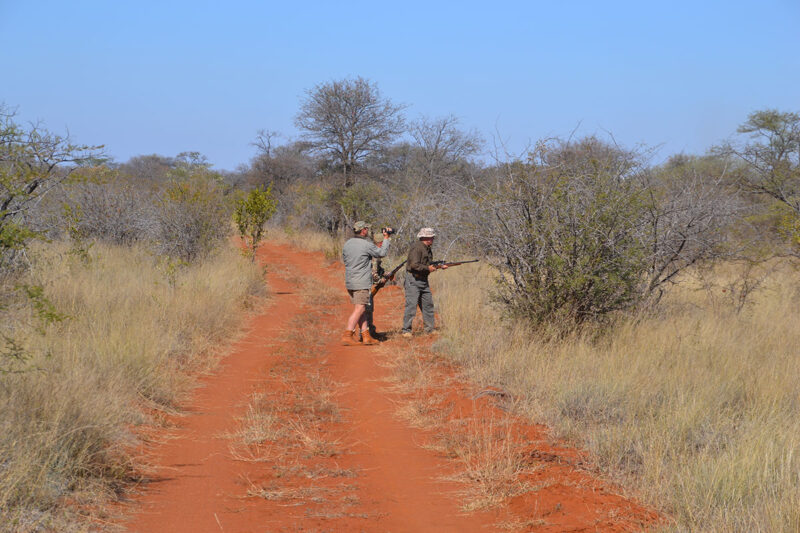
Fred makes ready for his final shot just off the side of a two-track.
Cape buffalo are magnificent creatures. Ranked among the dangerous game species of Africa, these animals are cunning and infamously unpredictable. They roam about in the thousands across much of that continent, and occasionally someone – hunter or otherwise – finds him or herself in difficulty with a buffalo. Regrettably, such meetings seldom end well. Still, buffalo are not lurking menaces constantly intent upon destruction. They most often go about their business of being buffalo. Regardless, they must be respected in all circumstances.
Three of us, all smitten with a wanderlust for Africa, were along on the trip. Seemed we found it impossible to avoid this adventure, the genesis of which came as an invitation from our friend and African PH, Louis Steencamp of Sofala Safaris. We succumbed to the pressure of that allurement and woke one Friday morning to the sound of bird call and brisk air in Africa. This was not our first safari, but this one was far more complex. We would hunt Cape buffalo, our first endeavor of such magnitude. We were as prepared as we could possibly have been, minus having done this identical regimen previously. A first in anything leaves room for much learning.
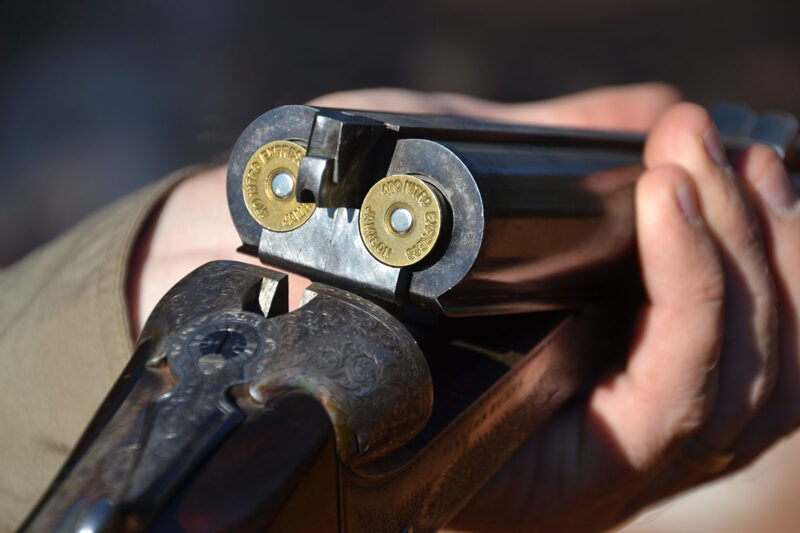
Huge cartridges of Louis’ .470 NE double are comforting when the going gets rough.
Louis always totes his big rifle, a British double chambered to the .470 NE. Fred employed a proven and well-proportioned Winchester Model 70 in 375 H&H. I had a custom 9.3X62, the rig built around a left-hand Remington 700 action. It turned out quite grand, an old cartridge that had quietly gone about its efficacious business of taking game of all persuasions since 1905. My 9.3 sparkled in this new package. Sam was either the bravest or most trusting among the group, for he had only a Nikon camera. His photos turned out well.
He did, however, even minus a rifle, want a warthog. He had taken one on an earlier safari but elected to try again. Warthogs can do that to a hunter. Curious-looking creatures, they are, but stalwart and cunning. A pleasurable addition to any hunt. Sam could use my wrong-handed 9.3 should an opportunity present. It did – midmorning of that last day. A superb boar. The 9.3 rose easily to task.

Sam and his warthog. Sam used Kinton’s custom 9.3X62 – left-hand rig, naturally.
Begging your pardon as I now take a divergent route in the telling of this story. Diminishing that import associated with the hunt itself is in no way intended. The hunt was splendid, dignified, a thing of grandiosity. Our rifles performed as they should and as we knew they would; all colleagues were properly tempered; the hunting was demanding and rich in its collecting of experiences. But please allow me to conclude this element by saying Fred and I took our Cape buffalo bulls, mine on the second day and Fred’s on the fifth. I elect here in this discourse to broach other matters. The hunt, after all, was why we had come, but Africa is so very much more than the hunting. And it is this more — those prefixes and suffixes and serendipities — that reverently seep into the core of any visitor and bring to realization greater specifics that highlight what this haunting and mysterious place is all about.
Vast expanses of wildness. Indescribable bird life. Night skies that draw eyes upward. Assorted cultures and languages and customs. Such addendums enhance the hunt, sprinkling it with wealth so great that it provides surety sufficient for a lifetime of contemplative enterprises. Wealth that is impossible to imagine without having encountered it. For this wealth resides not in legal tender but in remembering.
There are the sounds. The husky cough of leopard, a disturbance that brings shuddering to the hearer regardless of the times that hearer has been exposed to its rattle. That shuddering a near-certain appurtenance to the vocalization. A sensation that is sibling to chilled and sober reality of life and death along some two-track or at the base of a koppie or entangled in the confines of wait-a-bit thorns or amidst the uneasy rustling of tall grasses. Nights seem darker when a leopard coughs.
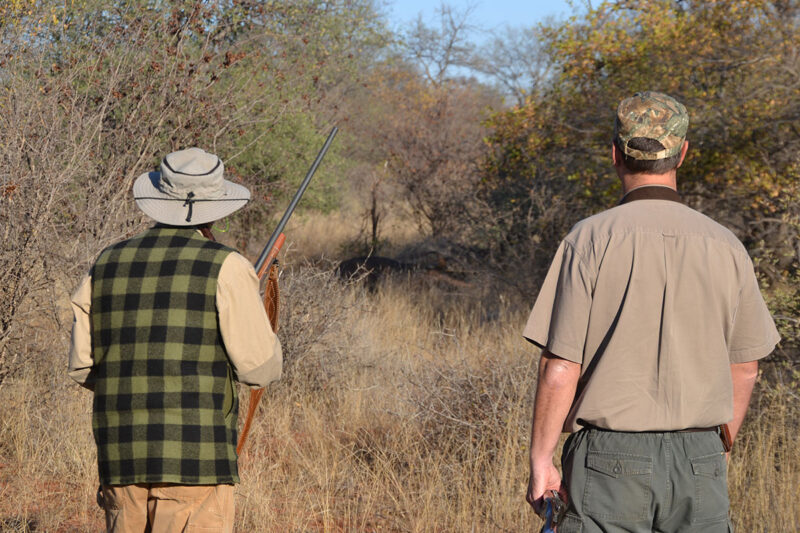
Kinton (L) and Louis approach Kinton’s bull, down with one shot from the 9.3.
And sounds that are far more benign. The comical grunting of an impala ram, his hormones coaxing him from caution, inciting battles with his fellows and over-playing his ardor with ewes. The obnoxious and haunting bark of baboons sequestered in or near higher-up rocky security, displeased with some infraction below and seemingly compelled to verbally take issue.
Less intrusive than the above just mentioned but steadily present and soothing, the cooing of doves is akin to a lullaby. If transferred to canvas, the cooing would be that crooked little smile of a sleeping infant, euphoria obvious. Gentle. A sound that instigates wellbeing. And louder than the doves, that telling of a go-away bird, the grey loerie, its parrot-like stature and prankish crest suggesting forthcoming mischief.
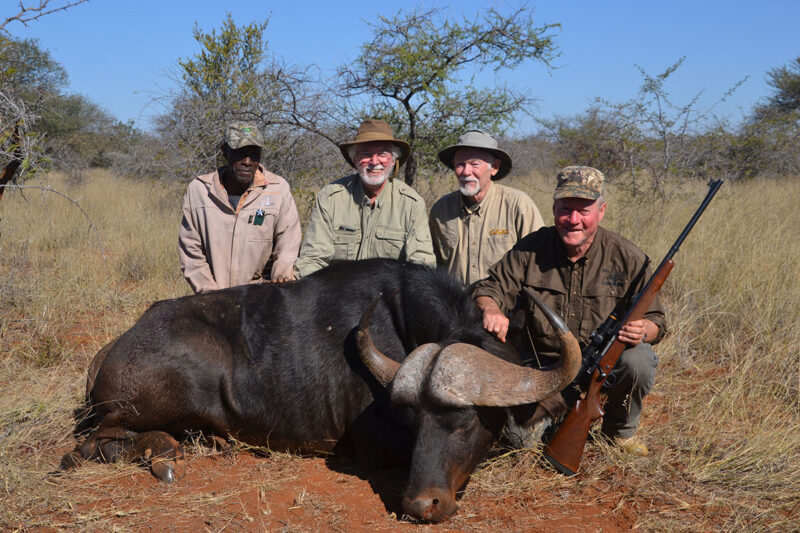
-(left to right) Willian, Sam, Kinton, and Fred pose with Fred’s bull, taken on the last day and with the old standard 375 H&H.
Visuals? In abundance. The grand and slick-barked baobab. The acacia, its flat top spread in a fashion that makes the observer conclude this tree stopped short in its effort to tower. Koppies, rock strewn and seemingly out of place, dot red soils here and there. These, the koppies, may house a den of some creature, afford sanctuary for klipspringers. A potential spot at these rocky protrusions, if the sun cooperates, for a brief respite and sip of tea near the bases. And sunrises and sunsets, glowing red and orange and greeting and dissuading.
And there are the comrades: hunters and PH’s and trackers. Visible and heard and comforting. All here in this land, a land that gives the concept of time has forgotten some smack of veracity.
I recall one particular evening where a great many factors outside the hunt touched every life there present. A bush-willow fire glowed in the pit. A grill sat over hot coals and buffalo back straps sizzled. Crackers and cheese and biltong and dry sausage and fruit were on the table. Talk was jovial but never boisterous. It was Sunday. There had been no church meeting in the bush that day, but Richard, a Presbyterian minister and Louis’ father-in-law, suggested we have an evening service. He passed out sheets of paper that held the words to a familiar and potent hymn.
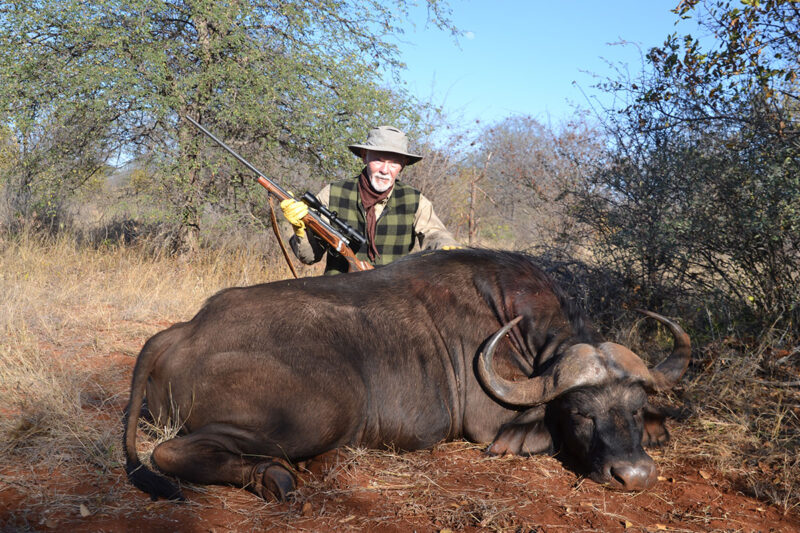
The author poses with his Cape buffalo.
With all seated around the fire, Richard read from the Bible, First Peter. One portion reminded readers and hearers to be humble and that they should cast all anxiety on God, for He cares. Most appropriate those words were. And then the song:
“O worship the King, all glorious above, And gratefully sing His wonderful love; Our Shield and Defender, the Ancient of days, Pavilioned in splendor, and girded with praise.”
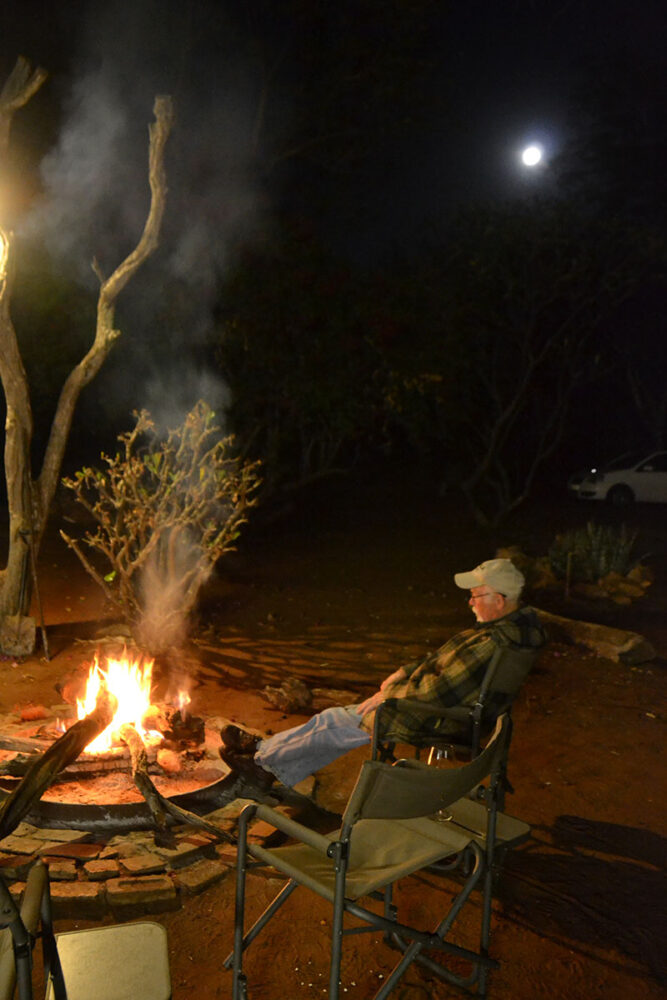
An evening fire is the centerpiece of an African camp. Kinton sits and reflects upon the hunt just ended.
We sang. Some with a Southern accent, others with that marvelous richness indicative of Africa’s pronunciation. A little harmony thrown in by those who either remembered what the chord structure looked like in the printed music or who picked out harmonious notes simply by ear. It was a grand sound drifting across bushveld, while the Southern Cross and Milky Way dangled above at finger-tip height on an exhilarating winter evening.
The hunt was spectacular, something that is common to this environ. But we did much more than hunt. We saw, we heard, we fellowshipped, we sang and we worshipped. In Africa.
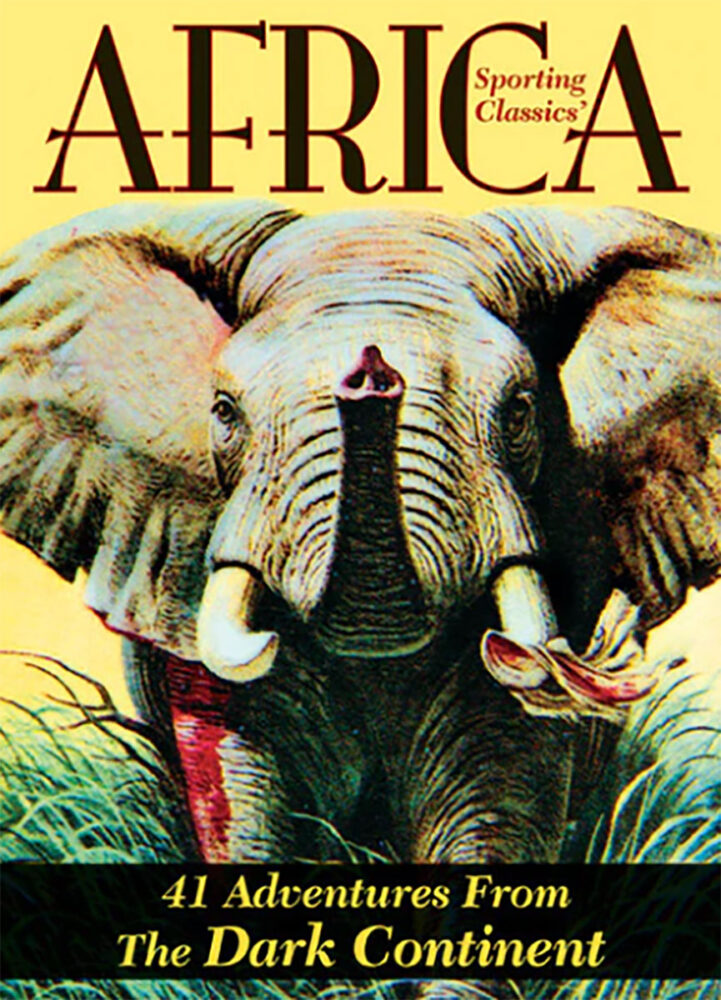 Featuring over 50 illustrations by world-renowned artist Bob Kuhn, AFRICA features more than 400 pages of unforgettable stories by some of the finest professional hunters and writers of sporting adventure. Buy Now
Featuring over 50 illustrations by world-renowned artist Bob Kuhn, AFRICA features more than 400 pages of unforgettable stories by some of the finest professional hunters and writers of sporting adventure. Buy Now

